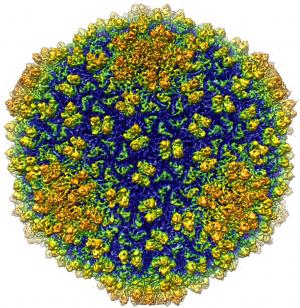
Viruses are sub-microscopic infectious agents that need other cells in order to reproduce. In fact, some scientists claim that viruses are not living beings, as they do not meet the criteria of the definition of life, because they don’t have cells; but they do have genes and evolve by natural selection. Still, they can be very harmful to us, so studying and understanding them is a must.
Now, a team of researchers from Purdue University has achieved images of a virus in detail two times greater than had previously been achieved. Wen Jiang, an assistant professor of biological sciences at Purdue, led a research team that was able to capture a three-dimensional image of a virus at a resolution of 4.5 angstroms by using the emerging technique of single-particle electron cryomicroscopy. Just so you get an idea, a pin has the diameter of a few million angstroms.
“This is one of the first projects to refine the technique to the point of near atomic-level resolution,” said Jiang, who also is a member of Purdue’s structural biology group. “This breaks a threshold and allows us to now see a whole new level of detail in the structure. This is the highest resolution ever achieved for a living organism of this size.”
“If we understand the system – how the virus particles assemble and how they infect a host cell – it will greatly improve our ability to design a treatment,” Jiang said. “Structural biologists perform the basic science and provide information to help those working on the clinical aspects.”
The team obtained a three-dimensional map of the protein shell of the epsilon15 bacteriophage, a virus that infects bacteria; it’s in fact one of the most abundant forms of life on Earth. They are planning to take things even further, and refine this process to improve the capabilities of the technique and to analyze more virus species.


